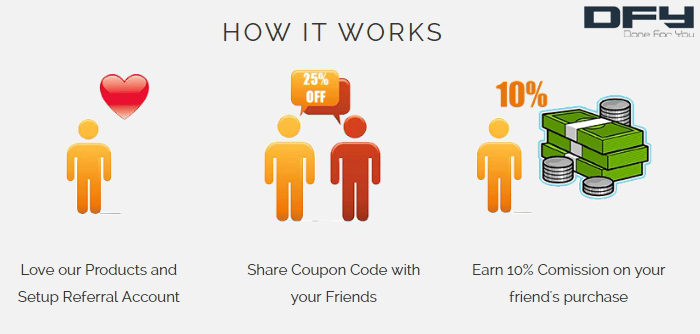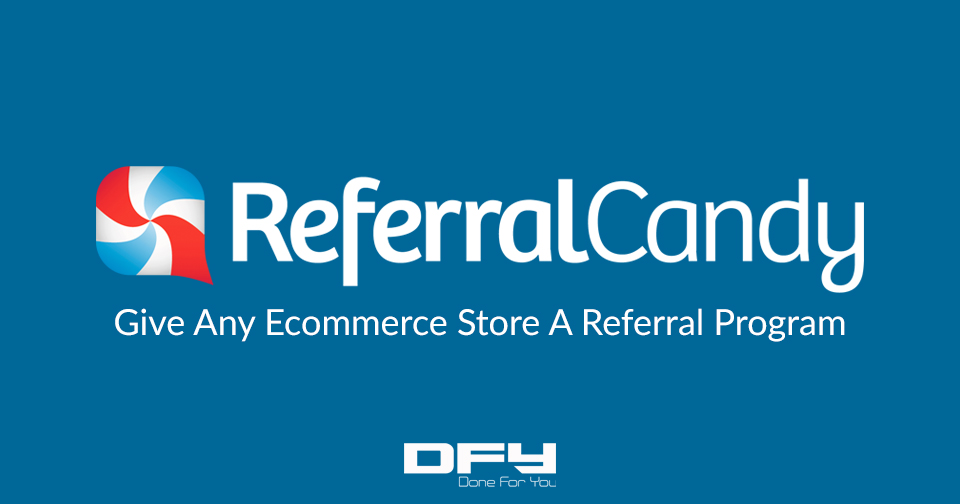This week we’ve been talking about e-commerce shit. I got a question from one of our clients yesterday about eCommerce referral programs.
How does an eCommerce Referral Program work?

Think of it this way, you have an affiliate program, there’s a JV program, as a referral program. Like all of those things incentivize people to send you customers. As an e-commerce store, what this means is like, let’s say you’re a clothing shop. You have this t-shirt that everybody’s just dying for. They’re selling off the racks. You’llll send that thing to an influencer and you have them wear it and you give them an affiliate code, so that every time somebody clicks that link in Instagram, somebody clicks the link in Facebook or TikTok or whatever, every time somebody clicks the link, then they get paid and you set the percentage.
The percentage might be 2% or 5% or 10% or, you know, whatever, 50%. But you set the percentage and software tracks the whole thing. You don’t need to worry about tracking anything. Basically, you know, they drop a link, somebody, one of their thousands, tens of thousands, hundreds of thousands of followers, click the link, come to your store, buy something, you get 95%, the influencer gets 5% or whatever. That’s the idea behind referral programs.
Setting-up eCommerce Referral Program
Now it used to be the eCommerce referral programs they sucked to set up and it was hard. It was just difficult. I mean, most affiliate programs, the good ones anyway, were kind of baked into CRMs like Infusionsoft or Ontraport or, you know, way back in the day. But now most solid e-comm providers, have referral program kind of add-ins.
Shopify
Referral commissions are 100% dependent on you.
The one we’re going to talk about today is Shopify. Shopify has some referral add-ons and if you don’t have Shopify, there are some other ones I’m going to talk about today. Before I talk about the software, one thing to know is referral commissions are, they’re a hundred percent dependent on you, but it’s kind of a two-way street.

You want to pay, you want to make it attractive for somebody to promote your stuff. So 5% might not do it. 10% might not do it. You know, somebody might need 15% or 20% to promote your products for you. The antithesis of that is true. In relatively unsophisticated markets, you know, 2% or 5% might be all they need. Like some of our clients in the info product space, well, so in one particular client, in an info product space, she does super, super, super well selling very, very niche video products.
She’s an influencer and she pays a 5% affiliate commission. And she has lots of affiliates who are, you know, signing up and promoting for that 5% affiliate commission, because it’s better than anything else in that particular niche.
Digital Products vs eCommerce Products
Now, on the other hand, digital products have no cost of goods sold. Most affiliates who sign up to sell digital products as an affiliate want 50% commission or 40% or 75% commission or whatever, because they know there’s no cost of goods sold. The only real cost is marketing for a digital product. You know, because there’s very little fulfillment, usually. There’s no, you know, manpower, there’s no delivery or shipping or storing or warehousing or whatever, you know? So e-comm products, on the other hand, there are always COGs. You always have the cost of goods sold. Somebody always pays to ship. I mean, shipping is never free, you know, somebody pays it.
Then you have people and labor and handling and all of that other stuff. For e-comm style, e-comm products have just greater cost to them, which means that you’re probably going to have to sell. You’re going to have to reduce that referral percentage down to 5%, 10% 15, something like that. The numbers have to work for you. They also have to incentivize your audience. It’s just something to think about.
Add-on Software:
Now, some of the software that you can use. Inside Shopify, they have add-ons. You can go in and add on additional software, additional functionality that will make Shopify run better, hopefully. It adds functionality. Although, it might not necessarily run better. It might slow it down.
It’s one of those things that you really need to work through, you know, test it out, install it, sign up for the free trial if it’s a paid thing. But some of the better affiliate referral programs for Shopify, there is the one that came up, the one that we use most often.

It’s end-to-end software. You set the percentage of how much you want to pay. Referral Candy keeps track of it, and then you pay it out through PayPal at the end of the month. Now, normally affiliate payments, how it usually works is you have like a 30-day grace period. After 30 days, whatever the next payout date is past 30 days, it might be 45 days, that’s when the checks go in the mail or that’s when PayPal actually sends that thing out. It just kind of starts month after month after month.
2. Smile
3. Bamboo
Another one that we like is Smile, and a third is Bamboo. So the one that we use most often here is Referral Candy, though. Once you get this referral code set up, you want to then hit your network of bloggers, influencers, friends on social media. Buyers is another one. If you have a list of, you know, 5 or 600 people who have purchased your product, send them an email and say, how would you like to make 10, 5%, or 10% by just sharing this link with your friends? You know, so very, very easy to add that on. Amazon is, I’m pretty sure the largest affiliate network in the world and they literally built their business around selling affiliate products through an affiliate program. So it’s just something to be mindful of.
Big Commerce
Now, if you don’t have, if you’re not using Shopify, let’s say you’re using Big Commerce or one of the other ones, there are a couple of other ways you can do it.
Add-on Software:
1. iDevAffiliate
2. Post Affiliate Pro
Post Affiliate Pro and then iDevAffiliate are two affiliates, they’re standalone affiliate softwares. Basically, you install the software on your own server, usually. They have hosted apps too, but you set it up so that you set it up on your website so that there’s basically a pixel that fires. The pixel fires on the thank you page. Then that tracks back to the affiliate and then this software maps out, you know, keeps track of who sent that sale, how much they’re owed, when their payouts are, and all that other stuff.
This is if you’re not using Shopify or if the software platform you’re in doesn’t have kind of that baked-in functionality. iDevAffiliate is awesome and Post Affiliate Pro is awesome. I’ve used iDevAffiliate more and it’s a great standalone software.
There’s one that used to be HasOffers. This is if you wanted to set up your own CPA network. If you have two or three or four, maybe clients or some friends who are operating e-comm stores, then you can set multiple people up in this. Tune is what it’s called now. It used to be HasOffers. And HasOffers or Tune keeps track of multiple vendors and multiple publishers.
You can have multiple affiliates publishing multiple or affiliating, multiple stores. It’s one of those, like, I mean, you then become an affiliate network, you know, so it’s very cool software. There’s a lot of opportunity in it. You just have to kind of know what you’re getting into. Managing a network is a much bigger job than just managing an affiliate program.
For Questions and Guide
If there is anything that we can do for you, just go to consultingsession.com, whether it’s you want to talk about an affiliate program to set up for your e-comm store or setting up an e-comm store, or you just want some help and some advice on how to get started or have a scale. Either way, let us know, and we will talk to you soon.